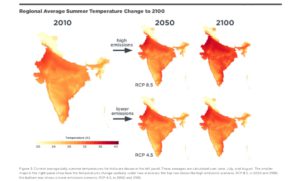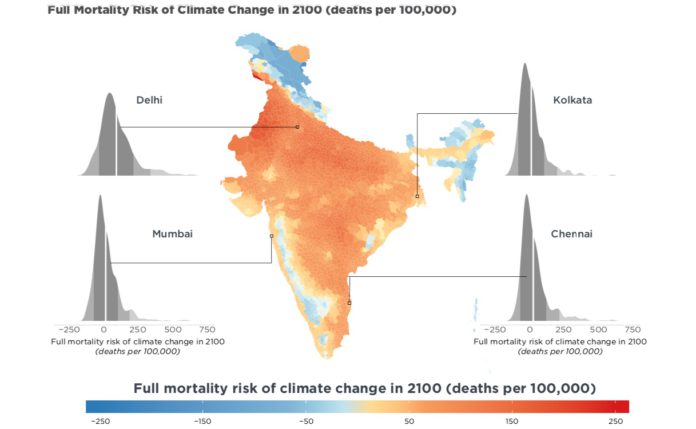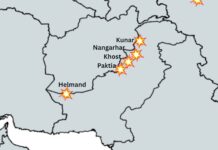New Delhi (NVI): More than 1.5 million people in India will die every year from the beginning of next century due to drastic rise in temperature caused by climate change, a study conducted by Climate Impact Lab in collaboration with the Tata Centre for Development at UChicago said.
The baseline climate induced death rate in the early 2000s in India is estimated to be 550 per 100,000 population and the continuous high emissions in India would see around an additional 60 deaths per 100,000 population in the year 2100, the study said.
The study projected that India would witness a 4°C rise in average annual temperature by 2100 due to continuous high emissions of greenhouse gases, with the average number of extremely hot days around the country over 35°C likely to increase by more than eight times per year from 5.1 (in 2010) to 42.8 in 2100.
In a high-emission scenario, the national capital of the country is projected to see 22 times more extremely hot days and more than 23,000 deaths caused by climate change per year from 2100. However, Odisha is projected to top the list when it comes to the highest increase in the number of extremely hot days, rising from 1.62 in 2010 to 48.05 by 2100. Punjab is expected to continue to be India’s hottest state in 2100, with an average annual temperature around 36°C.
 Currently in India, the deaths caused by climate change under a high emissions scenario are of comparable size to the reported death caused due to cancer or infectious diseases. They are approximately three times higher than the reported traffic accidents and one-third of the death rate caused by heart disease, stroke, and other cardiovascular across the country.
Currently in India, the deaths caused by climate change under a high emissions scenario are of comparable size to the reported death caused due to cancer or infectious diseases. They are approximately three times higher than the reported traffic accidents and one-third of the death rate caused by heart disease, stroke, and other cardiovascular across the country.
The study also projected that the use of energy in India will be more than double by the next 20 years (by 2040), driven largely by fossil fuels.
In the end, the study said that the mitigation has clear benefits for India. Being on a lower emissions trajectory would decrease the deaths from about 60 per 100,000 to about 10 per 100,000, adding that, “India is actually lower than the global average which is approximately 85 deaths per 100,000. But, by the end of the century, it is lagging far behind the current high-income countries, which have a total impact of about 5 deaths per 100,000 after having spent significant resources on adaptation.”
India has a significant margin by which it can reduce the mortality impacts of climate change. However, this will be costly, and that too in the high emissions scenario, the study added.











